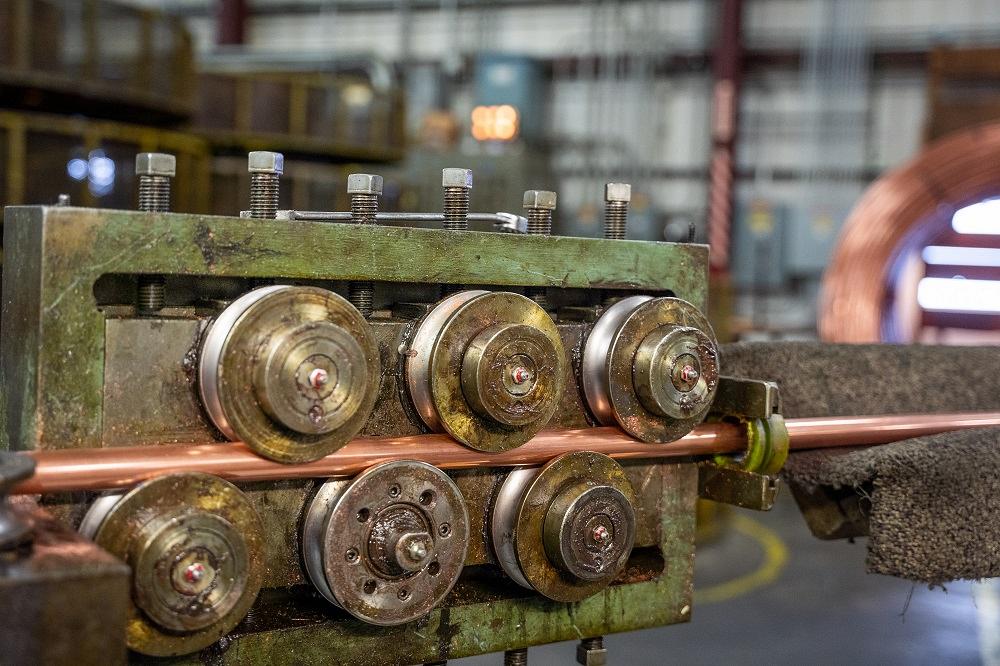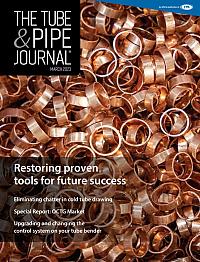Editor
- FMA
- The Fabricator
- FABTECH
- Canadian Metalworking
Categories
- Additive Manufacturing
- Aluminum Welding
- Arc Welding
- Assembly and Joining
- Automation and Robotics
- Bending and Forming
- Consumables
- Cutting and Weld Prep
- Electric Vehicles
- En Español
- Finishing
- Hydroforming
- Laser Cutting
- Laser Welding
- Machining
- Manufacturing Software
- Materials Handling
- Metals/Materials
- Oxyfuel Cutting
- Plasma Cutting
- Power Tools
- Punching and Other Holemaking
- Roll Forming
- Safety
- Sawing
- Shearing
- Shop Management
- Testing and Measuring
- Tube and Pipe Fabrication
- Tube and Pipe Production
- Waterjet Cutting
Industry Directory
Webcasts
Podcasts
FAB 40
Advertise
Subscribe
Account Login
Search
Michigan tube fabricator rebuilds line of cutoff machines
Instead of buying new equipment, H&H Tube restores proven tools for future success
- By Lincoln Brunner
- April 5, 2023
- Article
- Tube and Pipe Fabrication
Today is a big day for everyone at H&H Tube, Vanderbilt, Mich. (pop. 581). This supplier of fabricated tubular parts begins to find out if a calculated gamble on rebuilding its line of Vulcan Tool Ringmaster machines will pay off.
(Re)Building Tube Cutting Machines That Work
H&H Tube has been in business more than 90 years serving North American customers. It offers a variety of tube fabrication services, mainly for copper and brass parts: redraw milling, hydroforming, bending, and of course cutting.
Tube cutting—specifically the cutting performed by the company’s line of four Vulcan Tool Ringmaster tube cutoff machines—has brought H&H a lot of revenue over the years. Continued growth in that business presented the company with an interesting dilemma: add capacity with a new machine virtually guaranteed to meet tight tolerances, but at a cost premium, or reinvest in its current machines and rebuild them at a lower cost with the same technology in the new machine.
H&H actually chose both as part of a two-year partner program with Vulcan. Along with the purchase of one new Ringmaster machine commissioned a year ago (now called No. 1), the company will spend the next year and a half getting its No. 2 through 5 machines reconditioned.
“Within two years, we’ll have five almost brand-new machines so that we can support our customers’ growth,” said H&H General Manager Chong Mi Kim, a mechanical engineer who took the helm of the company two and a half years ago. “Current demand is higher than our production capacity and our customers want to grow their business; we need to be capable of supporting them.”
The decision-making process took some time, and for good reason—the 1960s-era machines process a sizable chunk of the company’s business and have been for years.
“We were running the equipment three shifts, six days a week,” said H&H Controller Mike Wilhelm, who’s been with the company for 10 years. “It’s a big segment of our business, so it’s important for us. This is a significant investment in the future that will enable us to expand capacity and improve performance.
“We’re putting many, many millions of cuts a year across that equipment. And you look at the cost of the material that goes through that equipment—I mean, it’s eye-popping. Vulcan told us they should be able to rebuild the machines and bring them back to original manufacturing specs and performance levels. We did the math [and said], ‘Wow, there’s potentially a lot of material savings there.’”
Restoration of Tube Cutting Machinery Proves Successful
The Ringmasters work on a fairly simple principle: Within the machine are a set of punches and a set of dies; one side is stationary; the other moves and performs the cut. The machines fit the cutting components closely with the ID and OD of the tube to mitigate deformation of the rings that the machine is cutting. And because there’s no sawing involved, material loss is virtually nil.
Today, one rebuilt Ringmaster (the No. 2) is going through its initial runoff. With a maximum OD capacity of 1-3/8 in., the machine is being tested with 1-in. copper tubing being fed from a coil and straightened before entry. H&H cuts about 5,000 rings per hour on the machine at about 28 rings per cycle.

Vulcan Tool Engineering Manager Joe Ritter (left) and Product Manager Matt Gonet talk things through during the initial runoff of one of H&H Tube’s rebuilt Ringmaster machines.
One of the main differences between the old machinery and the new and rebuilt Ringmasters is the new chuck holding the material in place—a feature that increases accuracy while requiring a lot less lubricant to move tubing through the machine to the cutting die.
“It has a chuck now to grab the part,” Kim said. “Because [the old machine] doesn’t have the strength to pull it, we use a lot of grease to overcome the friction. The machine, you can see it—it's very greasy. You don’t see it on the new machine. It’s almost nothing. It’s very clean.
“The old machines, we spent a lot of time putting tooling in, setting the parts, and then when something went wrong, fixing it all the time—so a lot of downtime. With the brand-new machine, it’s a lot more uptime, and a lot easier to change over.”
After tightening up a few components that had come loose during transport from central Ohio to northern Michigan, Engineering Manager Joe Ritter and his Vulcan teammates checked hydraulics, electronics, and tooling on the No. 1 and 2 machines. After conferring with H&H Product Lead Dan Neal, the Vulcan team continued to fine-tune the No. 2 bit by bit. As an ejector rod dropped freshly cut rings onto a ramp and into a bin, everyone agreed things were shaping up as well as they’d hoped.
“The quality of the cuts was great since we got those little kinks worked out,” Ritter said. “That’s the biggest thing with the older machines—they just take more maintenance. That’s what Dan and the maintenance guys were running into—he just has to pay more attention to the older stuff.
“The rebuilds are great because the main castings and the table and everything are usually OK,” Ritter added. “These machines have been running for years; things wear out and then it’s harder to center the dies and keep everything centered. What we did is just tighten up the tolerances on everything again. All the worn components are gone. There’s a pretty good price break on just taking a rebuilt machine versus a brand new one, and that’s why they did that. But it’s pretty much a new machine at this point.”
Strategy for Increasing Tube Fabrication Capacity
When Kim arrived at H&H Tube, she immediately saw the possibilities for the company.
“We knew that we needed to increase the capacity for cutting the copper tube—that was the bottleneck,” said Kim, who has a degree in mechanical engineering from the University of Cincinnati. “We had a choice of getting a little more sophisticated equipment and realized that [for] the four machines that we have, we have operators who are fully trained, we have a lot of tooling already, and all we need is simple cutting.”
So, considering the relatively low sticker price, the cost of it made total sense to H&H, as did sticking with the knowledge base the company had. While a new machine might have been fun, it would have been doing the same work and would have added the burden of a learning curve the company didn’t have capacity to complete.
“This equipment is the right technology for the application; we didn’t need to overcomplicate the process. It’s hard to find people to work for us, especially in northern Michigan,” Kim confided. “Bringing in new equipment that is totally different than what we have, that didn’t make any sense for us.”

The Ringmaster machines at H&H Tube can make virtually burr-free cuts at a clip of about 5,000 rings an hour. Images: Jordan Skutar, Stoneburner Video
Along with restored equipment comes a refocus on customer response time—a prevailing theme across industries whose growth has been stymied by over-reliance on foreign suppliers that haven’t been able to deliver the goods.
“Customers like domestic suppliers that can react quickly,” Wilhelm said. “That’s the No. 1 thing we hear from customers: ‘When can we expect our stuff?’ We want to get back to the short lead times that everyone has historically had.
“We want to be able to have reliable equipment,” he added. “When you have issues with equipment and you don’t know what you can count on, you can’t change on a dime and react, and you’re not going to do as well. I think of it as sort of a key renewal of some very key equipment for a nice chunk of our business—to put it on firm footing so we can handle conditions going forward and hopefully continue to grow that piece of the business.”
About the Author

Lincoln Brunner
2135 Point Blvd.
Elgin, IL 60123
(815)-227-8243
Lincoln Brunner is editor of The Tube & Pipe Journal. This is his second stint at TPJ, where he served as an editor for two years before helping launch thefabricator.com as FMA's first web content manager. After that very rewarding experience, he worked for 17 years as an international journalist and communications director in the nonprofit sector. He is a published author and has written extensively about all facets of the metal fabrication industry.
About the Publication
Related Companies
subscribe now

The Tube and Pipe Journal became the first magazine dedicated to serving the metal tube and pipe industry in 1990. Today, it remains the only North American publication devoted to this industry, and it has become the most trusted source of information for tube and pipe professionals.
start your free subscription- Stay connected from anywhere

Easily access valuable industry resources now with full access to the digital edition of The Fabricator.

Easily access valuable industry resources now with full access to the digital edition of The Welder.

Easily access valuable industry resources now with full access to the digital edition of The Tube and Pipe Journal.
- Podcasting
- Podcast:
- The Fabricator Podcast
- Published:
- 04/16/2024
- Running Time:
- 63:29
In this episode of The Fabricator Podcast, Caleb Chamberlain, co-founder and CEO of OSH Cut, discusses his company’s...
- Trending Articles
Zekelman Industries to invest $120 million in Arkansas expansion

3D laser tube cutting system available in 3, 4, or 5 kW

Corrosion-inhibiting coating can be peeled off after use

Brushless copper tubing cutter adjusts to ODs up to 2-1/8 in.

HGG Profiling Equipment names area sales manager

- Industry Events
16th Annual Safety Conference
- April 30 - May 1, 2024
- Elgin,
Pipe and Tube Conference
- May 21 - 22, 2024
- Omaha, NE
World-Class Roll Forming Workshop
- June 5 - 6, 2024
- Louisville, KY
Advanced Laser Application Workshop
- June 25 - 27, 2024
- Novi, MI



























